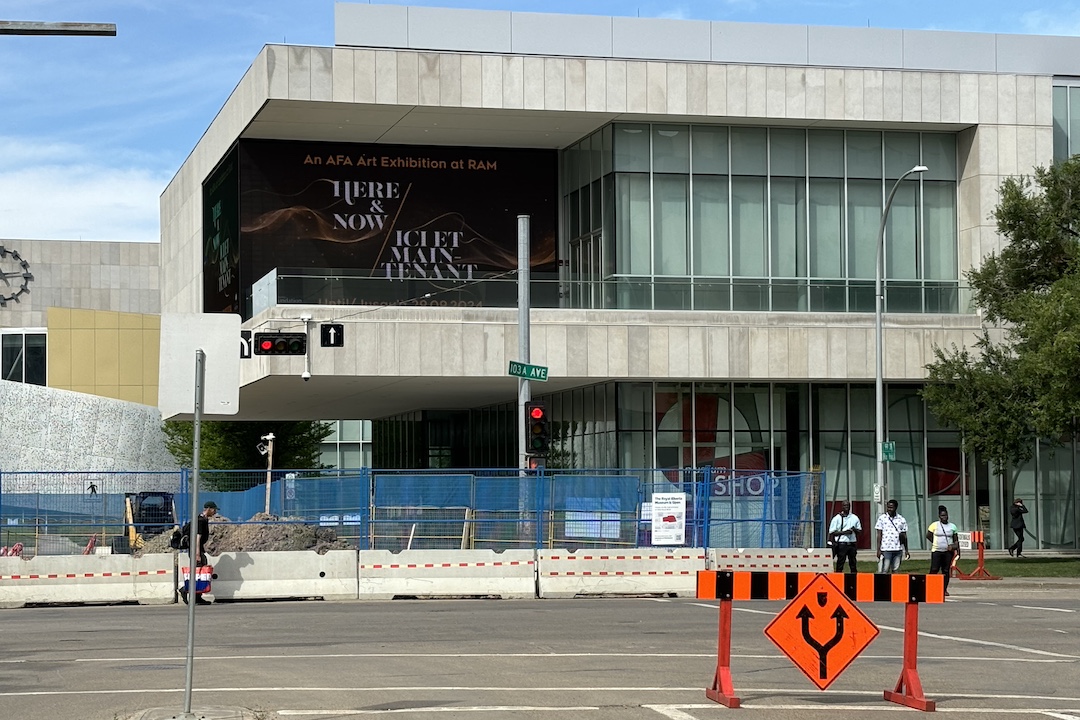The spear point, a bluish-grey stone shaped like a triangle with sharpened edges, caught the light as Kyle Forsythe, curator of archaeology at the Royal Alberta Museum, held it up to the camera. "The guy who brought it in thought it was an arrowhead," he told Taproot. "That's kind of the assumption when you find something like this. But bow and arrow technology has only been in Alberta for the last 2,000 years."
To gather the artifacts that people find within Edmonton and beyond, the Archaeological Society of Alberta holds Stones and Bones events along with museums around the province. The most recent was on Aug. 17 at Fort Edmonton Park. Organizers with the ASA told Taproot turnout was good, that they set up a practice dig site to help the public recognize artifacts typically found in Alberta, but no new artifacts were collected.
Forsythe said that people regularly find artifacts within Edmonton itself. The oldest archaeological site with multiple finds in the city, radiocarbon dated to be 10,000 years old, is on the outskirts. The exact location of this site is confidential, he said, to keep the artifacts there safe. But he said there are artifact sites throughout the city aged between 500 years old and a staggering 10,000.
Some may know that the Strathcona Science Provincial Park, just east of the city, formerly had an archaeological dig site, where archaeology students dug out bones, pottery, and quartzite in the 1970s and '80s. More recently, in April, a couple inside the city were landscaping their yard when they found a black rock that looked like a piece of glass. The rock turned out to be a 4.6-pound chunk of obsidian core, or volcanic glass. The RAM is currently involved in figuring out that dazzling find.
Most Edmonton residents are not finding ultra-rare obsidian rocks. Instead, the most common artifact people find inside city limits is quartzite (rock) bifaces — or objects made of quartzite that's been chipped on two sides to make a working edge. Forsythe said such quartzite is found everywhere in Alberta, and that the biface was the Swiss Army knife of the ancient world, used for cutting, as a spear point, as a scraper, or many other things.
Beyond quartzite, when it comes to finding more easily identifiable artifacts like arrowheads, spear points, stone knives, and scrapers, Forsythe said it's important that people do not take them from where they are found. "Reason being that the most important thing to us archaeologists is the spatial context, so the contacts between different artifacts is what allows us to reconstruct what happened in the past," Forsythe said.
Instead of picking it up, he recommends taking a picture and sending GPS coordinates to the museum or the archaeological survey through the report a find service.

The new Royal Alberta Museum building opened in 2018, and is now the home of the provincial collection of artifacts collected from around the province, including numerous ones found within Edmonton's city limits. (Tim Querengesser)
It's common for people to donate artifacts to the museum, and legally speaking, any artifacts people do find in Alberta are the property of the province. The museum has the responsibility to look after them.
The Stones and Bones events help connect people with experts to determine what may or may not be an artifact. "We'll typically bring out an archaeologist, paleontologist, and geologist, and we'll cover all our bases," Forsythe said. The team assesses what people bring in and decides where they should go. In bigger cities like Edmonton, the turnout for such events can number to more than 1,000 people, Forsythe said, while in smaller places like Claresholm or Pincher Creek, it can be less than 100.
The events in rural areas bring in artifacts despite the low numbers. Lots of farmers bring artifacts in for assessment that they've found in their fields, Forsythe said.
Once people donate items they are also able to visit the museum and see them there, or have a cast replica of the artifact created, Forsythe said.
Stones and Bones events are a good way for people to become involved with the ancient history of the province, but for people who want a more hands-on approach, Forsythe suggested the Bodo Archaeological Site, where anyone can try their hand at working on the dig site. The Bodo site dates back 5,000 years, and has day camps for adults, kids, and schools.
What about the spear point Forsythe held under the light? It was not found in Edmonton but rather was sent to the RAM by a couple in the Peace River region after having it in their possession for 30 years. Forsythe said it's roughly 9,000 years old.
